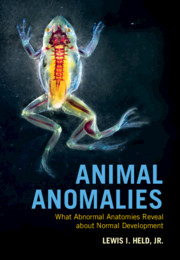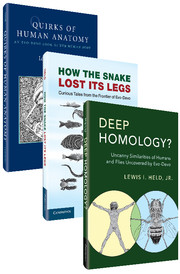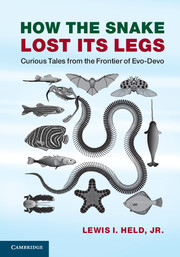Animal Anomalies
What Abnormal Anatomies Reveal about Normal Development
$41.99 ( ) USD
- Author: Lewis I. Held, Jr, Texas Tech University
- Date Published: March 2021
- availability: This ISBN is for an eBook version which is distributed on our behalf by a third party.
- format: Adobe eBook Reader
- isbn: 9781108890793
Find out more about Cambridge eBooks
$
41.99 USD
( )
Adobe eBook Reader
Other available formats:
Paperback, Hardback
Looking for an examination copy?
If you are interested in the title for your course we can consider offering an examination copy. To register your interest please contact [email protected] providing details of the course you are teaching.
-
Among the offspring of humans and other animals are occasional individuals that are malformed in whole or in part. The most grossly abnormal of these have been referred to from ancient times as monsters, because their birth was thought to foretell doom; the less severely affected are usually known as anomalies. This volume digs deeply into the cellular and molecular processes of embryonic development that go awry in such exceptional situations. It focuses on the physical mechanisms of how genes instruct cells to build anatomy, as well as the underlying forces of evolution that shaped these mechanisms over eons of geologic time. The narrative is framed in a historical perspective that should help students trying to make sense of these complex subjects. Each chapter is written in the style of a Sherlock Holmes story, starting with the clues and ending with a solution to the mystery.
Read more- Instructs readers in what we know about the pathways pursued by embryos and evolution, and stresses what we do not yet know
- Shares interesting findings about the etiologies of weird animals
- Uses case studies to tell stories, illustrating deep scientific principles
Reviews & endorsements
‘With rigorous arguments presented in captivating prose and crystal-clear drawings so rich in information, this new masterpiece by Lewis Held is a unique introduction to the genetics of development. Here, monstrous and normal illuminate each other, as products of the same developmental logic. This book is full of inspiring insights, on a par with the works of the great developmental biologists highlighted in its pages.’ Alessandro Minelli, University of Padova, Italy, and author of Understanding Development
See more reviews‘Orthodoxy is so rife in science these days it is strangling originality. The spread of ’best practice’ as well as the related belief that there is only one ideal way to understand and explain things has stifled both diversity and imagination. … Lewis Held shows us there is another way - to look at the natural world open-mouthed and open-minded. We are taken on a lively ramble through myriad natural phenomena in countless species and the attempts of scientists to understand them. There is an infectious sense of the wonder and complexity of everything. There are innumerable nuggets to be found and it is fun. … His book sings like the descant in a choral rendition of a familiar hymn. I recommend it, but don’t try and read it all in one go!’ Peter A. Lawrence, University of Cambridge, UK
‘In this wonderful exploration of development, Lewis Held uses both familiar and less-well-known examples of frogs, flies, dogs, and cats to delve deeply into the underlying biological principles their traits can illustrate … Held also describes the genetic basis of traits that pet-owners find endearing … In addition to this fascinating exploration of genetic mechanisms and their outcomes is another idea that I have always valued in Lewis Held’s work: the respect for pioneering insights and discoveries by earlier researchers like Curt Stern, Walter Gehring, Ernst Hadorn, and others. I remember hearing a faculty advisor once criticize a new graduate student for planning to cite a research article that was more than a couple years old as being irrelevant to ‘modern research’. Thankfully, writers like Held remind us that the story of discovery is a long one, and critical insights can come from anywhere.’ Jim Thompson, Drosophila Information Service
‘Recommended. Graduate students and faculty.’ D. A. Brass, Choice
‘The volume is a very readable deep dive, written as a romp through a series of mysteries and associated detective stories, some of which have been fully solved, others not … Held is able to provide detailed explanations of the underlying developmental-genetic mechanisms that produce the variation … because he assumes a basic knowledge of cell signaling mechanisms, he is able to present the information at a much deeper level than most popular evo-devo books can … the volume should interest a wide range of readers, from advanced undergraduates through emeritus professors.’ John Reiss, The Quarterly Review of Biology
‘… the diagrams are detailed and fascinating, but outstanding in Animal Anomalies are the photographs. We are all so used to the way the world ‘should’ look, we can’t help but be stopped in our tracks when confronted with something so unexpected as, for instance, an otherwise healthy frog who, mouth open, shows us its eyes looking out from the roof of its mouth. … Animal Anomalies is a breathtaking sweep of ‘things gone wrong,’ that all illuminate some of the critical steps in normal animal development.’ Mark Terry, American Biology Teacher
Customer reviews
Not yet reviewed
Be the first to review
Review was not posted due to profanity
×Product details
- Date Published: March 2021
- format: Adobe eBook Reader
- isbn: 9781108890793
- availability: This ISBN is for an eBook version which is distributed on our behalf by a third party.
Table of Contents
Preface
Part I. Frogs:
1. The introspective frog
2. Two-headed tadpoles
3. Extra-legged frogs
Part II. Flies:
4. The double-jointed fly
5. The four-winged fly
6. The naked fly
Part III. Dogs:
7. The Shar-Pei
8. The bully whippet
9. The Great Pyrenees
Part IV. Cats:
10. The blotched tabby
11. The Siamese cat
12. The calico cat.
Sorry, this resource is locked
Please register or sign in to request access. If you are having problems accessing these resources please email [email protected]
Register Sign in» Proceed
You are now leaving the Cambridge University Press website. Your eBook purchase and download will be completed by our partner www.ebooks.com. Please see the permission section of the www.ebooks.com catalogue page for details of the print & copy limits on our eBooks.
Continue ×Are you sure you want to delete your account?
This cannot be undone.
Thank you for your feedback which will help us improve our service.
If you requested a response, we will make sure to get back to you shortly.
×





